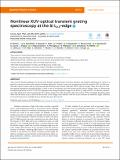Nonlinear XUV-optical transient grating spectroscopy at the Si L2,3–edge
Author(s)
Bohinc, R.; Pamfilidis, G.; Rehault, J.; Radi, P.; Milne, C.; Szlachetko, J.; Bencivenga, F.; Capotondi, F.; Cucini, R.; Foglia, L.; Masciovecchio, C.; Mincigrucci, R.; Pedersoli, E.; Simoncig, A.; Mahne, N.; Cannizzo, A.; Frey, H.M.; Ollmann, Z.; Feurer, T.; Maznev, A. A.; Nelson, K.; Knopp, G.; ... Show more Show less
DownloadPublished version (1.412Mb)
Publisher Policy
Publisher Policy
Article is made available in accordance with the publisher's policy and may be subject to US copyright law. Please refer to the publisher's site for terms of use.
Terms of use
Metadata
Show full item recordAbstract
Time-resolved transient grating (TG) spectroscopy facilitates detailed studies of electron dynamics and transport phenomena by means of a periodic excitation of matter with coherent ultrashort light pulses. Several current and next generation free-electron laser (FEL) facilities provide fully coherent pulses with few femtosecond pulse durations and extreme ultraviolet (XUV) photon energies. Thus, they allow for transient grating experiments with periodicities as small as tens of nanometers and with element specific photon energies. Here, we demonstrate the element specificity of XUV TG (X-TG) experiments by tuning the photon energy across the Si L₂,₃-edge of Si₃N₄. We observe a shortening of the signal decay when increasing the XUV photon energy above the absorption edge. The analysis of the wavelength dependent signal shows that the faster decay is driven by the increase in the charge carrier density. From the decay constants the interband Auger coefficient at elevated temperatures and high electron densities has been determined.
Date issued
2019-05Department
Massachusetts Institute of Technology. Department of ChemistryJournal
Applied Physics Letters
Publisher
AIP Publishing
Citation
Bohinc, R. et al. "Nonlinear XUV-optical transient grating spectroscopy at the Si L2,3–edge." Applied Physics Letters 114 (May 2019): 181101 © 2019 Author(s).
Version: Final published version
ISSN
0003-6951
1077-3118